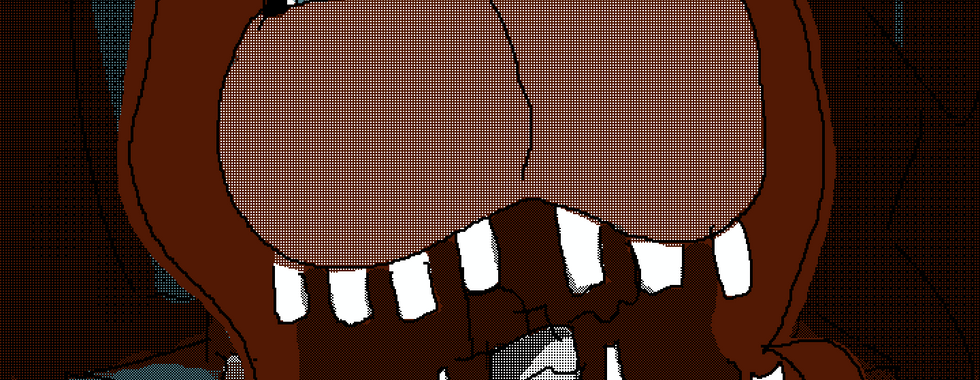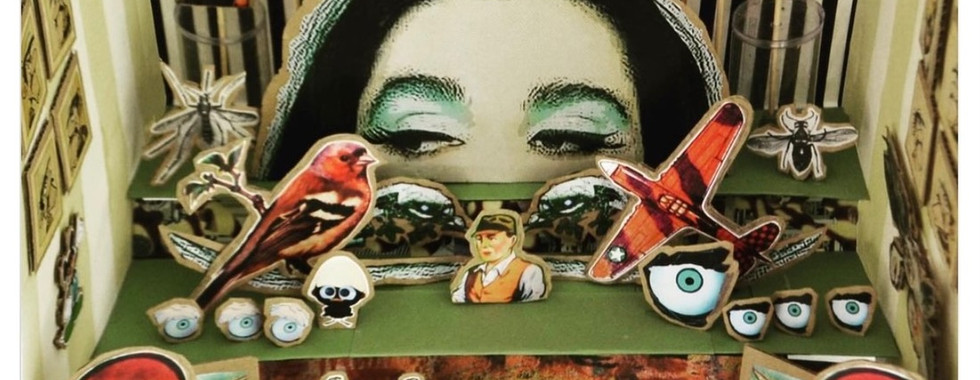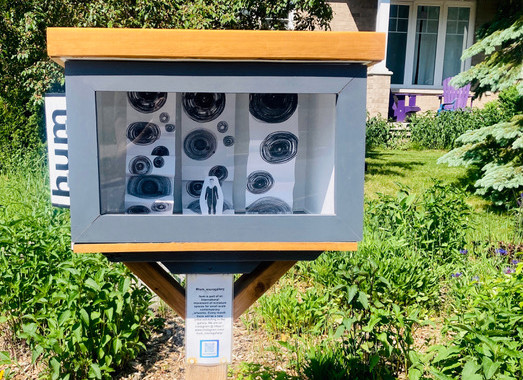Elsewhere: Two unconventional communal spaces presenting art

Michéle Provost - "Spot the Difference"
Anishare and HUM Microgallery are two exhibition platforms closing the gap between space and spectator
Words by Glesni Williams
ISSUE 15 | OTTAWA & TORONTO | SPACES
The stereotype of the “white cube” exhibition space has long been left behind. From institutional museums and commercial galleries, to independent art spaces, both the presentation and collective experience of visiting exhibitions, artworks, and installations are undergoing revolutions. Traditional white walls—an aesthetic practice dating back to the early 20th century in response to the increase in abstract works which required a neutral background—are no longer a given. Instead, new forms and aesthetics of space, curation, and public engagement are reshaping how we view and interact with art.
Exhibition spaces themselves are social containers, and should not be viewed or treated as static environments. Evermore today, these spaces must understand their public as heterogeneous and multicultural, moving away from the exclusivity and elitism often reinforced by the social norms of the art world. Galleries are becoming spaces of gathering. This represents a shift away from historical conventions of the museum, which have not always prioritized dialogue, or sustainable social practices which value interaction between the viewers themselves, within the context of the art space.
Today, the digital realm is as significant a space for art as physical galleries, offering a parallel dimension for artistic engagement that holds equal cultural value. Emerging “third spaces”—hybrid venues blending physical and digital elements—are forming within communities, taking root as active hubs for art and culture. These unconventional spaces defy the need for traditional structures, such as four walls, or shopfronts. Instead, they thrive through an “architecture of persons:” existing and gaining recognition through the communities that gather around them, whether online or in person.
Anishare is one such digital space. Created by Toronto-based Software Developer Javan Graham, Anishare is a collaborative social platform, which brings together online users the world over, encouraging participants to create, share, and view animations—whether designed by friends or artists. Only recently available through invitation, having been launched in the summer of 2024, Anishare is very much a developing shared space. The space invites online users of varying skills and experiences to discover the world of animation, and shared collaboration and creativity. Unconventional in its approach to reaching an audience, its existence relies on the establishment and participation of an online community, and therefore an architecture of persons. Together, those who enter into the space experience creating, sharing, and enjoying design, digital art and animation.


Today, the digital realm is as significant a space for art as physical galleries, offering a parallel dimension for artistic engagement that holds equal cultural value. Emerging “third spaces”—hybrid venues blending physical and digital elements—are forming within communities, taking root as active hubs for art and culture. These unconventional spaces defy the need for traditional structures, such as four walls, or shopfronts. Instead, they thrive through an “architecture of persons:” existing and gaining recognition through the communities that gather around them, whether online or in person.
Anishare is one such digital space. Created by Toronto-based Software Developer Javan Graham, Anishare is a collaborative social platform, which brings together online users the world over, encouraging participants to create, share, and view animations—whether designed by friends or artists. Only recently available through invitation, having been launched in the summer of 2024, Anishare is very much a developing shared space. The space invites online users of varying skills and experiences to discover the world of animation, and shared collaboration and creativity. Unconventional in its approach to reaching an audience, its existence relies on the establishment and participation of an online community, and therefore an architecture of persons. Together, those who enter into the space experience creating, sharing, and enjoying design, digital art and animation.
THE DIGITAL THIRD SPACE
What inspired you to create Anishare as a digital gathering space, and how do you hope the platform’s blend of elements of GarageBand and TikTok will foster artistic collaboration?
JG ─ My biggest inspiration for creating Anishare comes from my experience with using Flipnote Studio on my Nintendo DSi, back in 2009. That was my first time really animating, or using a social platform, and so it defined my prototypical social media experience. It was amazing seeing what other kids around the world could create. Since we all had access to the same tool, it gave you that feeling that, with time and effort, you could make anything you could imagine.
On Anishare, the emphasis is on real-time collaboration, which takes the labour of animating, and turns it into a fun, creative, spontaneous game—especially when you're in the same room, or on a voice call with your collaborators. The editor is also meant to be simple and accessible to all skill levels and devices, so the focus shifts from perfectionism towards free flowing self expression, and just seeing your drawings come to life.
Once the animations are complete, the creators can publish them on the platform for other users to engage with, as you would on other social sites. Users can follow, like, comment, and even remix animations if allowed by the creators, which is a great form of asynchronous collaboration and "meme generation". This is what gives all these creations, and their creators, a place to call home.

Moving towards the non-linear, exhibition spaces morph in form and size. Today, it is no longer necessary for art lovers to physically step inside a space, in order to view and enjoy an installation or show. HUM Microgallery—created by artist Lynda Cronin—is exactly as it says on the tin, a very small art gallery. Similar to a postbox in size (5x7.5cm for scale), HUM is a small, accessible public space, located on a suburban Ottawa street, open to the elements, where anyone can get up close and discover contemporary art, and ideas, presented in an innovative way. Part of an international movement of miniature spaces for small scale contemporary artworks, HUM first opened in April 2022, and has since hosted a variety of exhibitions—from the inaugural poetry work of Laurie Koensgen, to Sue Ukkola’s found objects, and miniature theatre set up by Peter Wallis. The gallery invites viewers up close to the exhibition, thanks to its small size. This way, a personal connection is made between space and spectator. This is not always possible in traditional exhibition spaces. Visitors leave with a sensation of having seen and experienced an exhibition like no other.
UPSIDE TO DOWNSIZING
HUM Microgallery showcases intimate, small-scale works. What inspired this, and how do you believe these smaller pieces offer a unique experience?
LC ─ Many years ago, I was walking around Leslieville in Toronto’s East End, and came across an art installation, in a small exhibition space along an urban street. There was something so special and unique about this encounter—unexpected, an embracing of contemporary art in a community setting. This kindled my interest in wanting to someday offer such an experience to my community, and to connect with artists in a more direct way. Many years later, I installed HUM in my front garden and, through Instagram, have been able to develop a relationship with many other micro galleries in various countries.
The micro gallery is far-removed from the commercial art gallery, where economics play a central role. These small spaces offer multiple ways of engagement, and encourage experimentation on a small scale. Artists can produce work that are diminutive or expansive, free to imagine larger works without the expenditure of full scale production.
The concept of a micro gallery suggests a close, personal interaction between the artwork and the viewer. How does this intimacy influence the way people engage with and interpret the pieces on display?
LC ─ The micro gallery is set within an urban community, where exposure to contemporary art might be minimal. Often, locations are where the owners live, and the intentions are as varied as the individuals that create them. Social media compliments the physical space, by broadening the exposure for artists, and connecting with other like-minded individuals who want to support artists in this way.
The artists that have supported HUM have come from Mexico, the UK, the US and within Canada. There is a sense of unity among the artists who have chosen to exhibit at HUM. A belief in the benefit and progressive role that these alternative spaces provide, and where they can contribute to broadening the kind of interaction artists can have in a community. Often, I will get a message from a runner or a dog walker who has recently seen an exhibition, and is eager to share their experience. This is the intimate experience that these spaces have to offer. Viewers can interact with the artwork on their own terms, casually, and without any expectations or preconceived notions about having to “understand” contemporary art practice.
There is a curated aspect to HUM, which attempts to provide space for innovation and experimentation, and to bring this perspective to someone who may not have the time to visit a museum or other commercial gallery space.
How does HUM create a “third place” for gathering?
LC ─ Micro galleries are everywhere: on the sides of buildings, front gardens, and in store fronts. What they all have in common is a willingness to be experimental, and to offer more opportunities to working artists. Small spaces can contribute to building large works─some artists working on a concept use these small spaces as a form of maquette building, a scaled-down version of a larger installation, or public art piece. Micro galleries are not intimidating. They offer a safe and easy way to explore ideas, in a no-fuss setting, within a local community space.
With the gallery so exposed, are you at all worried about vandalism or graffiti?
LC ─ HUM has been in operation for close to three years, and there has not been any kind of interference other than the weather─last year, snow and ice damaged the sign. This was kindly replaced by an online follower. Such are the benefits of having an interested and engaged international, online community, as well as a local focus.




















